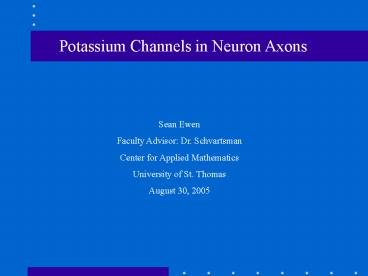Potassium Channels in Neuron Axons PowerPoint PPT Presentation
1 / 18
Title: Potassium Channels in Neuron Axons
1
Potassium Channels in Neuron Axons
Sean Ewen Faculty Advisor Dr. Schvartsman Center
for Applied Mathematics University of St.
Thomas August 30, 2005
2
Introduction
- The nervous system comprises the electrical
network of the human body - It is responsible for our thoughts, senses, and
movements
- Our nervous system transmits information
incredibly fast - What processes account for this transmission?
- What mechanisms drive these processes?
- What does Math have to do with this?
3
The Basic Anatomy of a Neuron
4
Anatomy of an Axon
- Think of the axon as a cable or electrical wire
- They both have a membrane or insulation
- However, axons have many channels that allow
ions to pass through the membrane - Axons have intracellular space where cables
would have bundled wires
Vertical Cross-section of Axon
Membrane
Intracellular Space
Ion Channels
5
The Action Potential
- Axons act as electrical wires, carrying current
and charge - Most human axons have a resting potential at -70
millivolts (mV) - When at resting potential, the axon acts as a
capacitor - Electrical charge moves through the axon like a
wave - This is called the action potential
- The level of charge dictates which and how many
ions come through channels
6
The Action Potential
- This graph shows an action potential at any
given point
Threshold Potential
Resting Potential
7
The Action Potential
- The action potential is driven by the
differences in potential that occur along the
axon - The movement of ions in and out of the axon
drives these differences in potential - The following animation is a good description
http//www.blackwellpublishing.com/matthews/channe
l.html
8
Speed of Action Potentials
- Potentials propagate anywhere from 0.1 to 100
meters per second - Speed depends on
- Higher temperature faster speed
- Bigger axon diameter faster speed
- Myelin sheath (insulation) faster speed
9
Nervous System Reaction Times
- Varies person to person
- On a self-test my average was 390 milli-seconds
- This test involved a motor function after a
visual stimulus
10
A First-Order Equation
- We are studying potassium in axons because
- Potassium is much less dependent on potential
- Its actions are subtle and sensitive to changes
- A first-order equation reflects properties of
kinetics - It can model population growth and other common
practical applications - In our case, it applies specifically to
potassium channels
11
A First-Order Equation
- Based on concentration (between 0 and 1) of open
channels and time
Rate channels go from open to closed
Rate channels go from closed to open
dn a(V) (1-n)?1 - ß(V) (n) ?2
? concentration
dT
? time
Concentration of closed channels
Concentration of open channels
- Concentration of open channels (n) is higher at
higher voltages
12
A First-Order Equation
- The equation can be represented as an
equilibrium - Closed Channels Open Channels
a
ß
- In a first-order equation, ?1 ?21, according
to the rules of kinetics - Our model may or may not be first-order
13
Finding Change in Time
- At high voltages ( gt 40mV) ß(V) is close to or
is zero, so we can drop the term - ß(V) (n) - Next we isolate dT to get dT dn
a(V)(1-n)?
- Take the integral and set the limit between 0
and 1
1
T dn
a(V)(1-n)?
0
- Since its possible the equation is not first
order, gamma may not be equal to one
14
Finding Change in Time
- This is a graph of the alpha and beta rates
along different voltages
Alpha
Beta
Rate
Voltage (mV)
15
Finding Change in Time
- Graph of T(?) at 40mV
Time (ms)
?
- Best fit seems to be ?1/8 (or 0.125) as curve
begins to level out
16
Finding Change in Time
- T(40mV) 3.62 milliseconds
- This is time it takes for channels to become
completely open at 40mV - Change in time seems to have an inverse
relationship with voltage - As voltage rises, change in time decreases
- As voltage decreases, change in time increases
17
Conclusion
- We now know what carries the signal - the action
potential - But can this account for the incredible speed of
the nervous system? - A quantum hypothesis of brain function and
consciousness suggests - There may be interactions that occur at quantum
levels - There may be other processes that scientists are
not aware of yet
18
Future Research
- How do other ions play a role in the action
potential? - Further modeling with the Hodgkin-Huxley
Equation - How can synaptic transmission be modeled?
- What other associative processes influence the
action potential?

